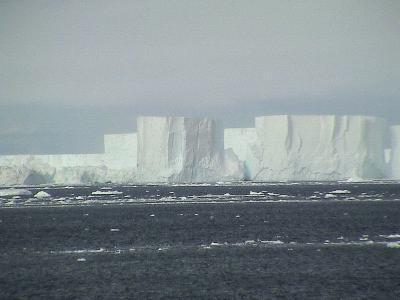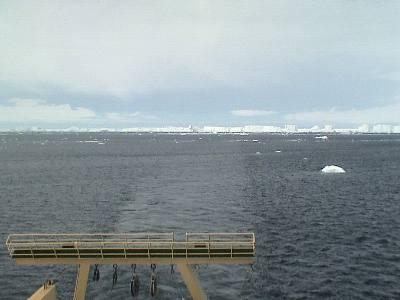21 January, 2004
At midnight we deployed the mutichannel seismic streamer. The
streamer is a complex bundle of wires, microphones and electrical
components all bundled into a 1500-meter long cable. With the aid of
"birds" that connect to the streamer and have controllable wings, the
scientists are able to level the streamer at a depth of twenty feet
below the surface. The streamer stretches out behind the ship like a
yellow and orange stripped snake. It is essential that the streamer
stay as straight as possible during the data collection.
The streamer is really a series of microphones (hydrophones)
positioned a known distance apart. They record the echoes produced
by the surface and subsurface features of the Earth's crust. From
these echoes the geoscientists can peer into the layers of the crust
looking for faults, volcanoes, and other structures. The echoes
reflect back to the microphones as different rates the deeper that
they penetrate into the crust. These differences in time represent a
difference in depth and in the physical characteristics of the rocks
and sediments that make up the crust in that area.
To produce the reflected sounds, high-pressure air cannons operate at
2000 lbs per square inch. When the cannons are fired the produce a
low frequency pulse that travels down through the seawater and is
reflected by the different layers in the crust back to the
microphones in the streamer. There are six air cannons in an array
that are towed behind the ship below the surface. They are connected
to the ship by cables, electrical wires and hoses. They are attached
to six buoys so that they do not sink too low below the surface.
We are in normal watch standing mode for the first time. Each team
of three rotates between recording watch data, beam editing and
Marine Mammal Observing. No whales or seals were observed today,
only a few penguins on icebergs that floated by the ship. Changing
duties makes the time pass by very quickly, and the interludes are
filled with discussions about the maps and charts that are being made
from the initial data.
Ashley Lowe (MPC) gave us a briefing on working on the back deck.
The marine techs are very willing to show us how the equipment
operates and have invited us to help them in retrieval and deployment
of the equipment during the course of the cruise. There is a
cooperative spirit between the science team, the marine support and
the crew. Everyone is made to feel welcome and important to the
success of the cruise.
The size of B15A is amazing. We transit for hours and the berg is
always in our portholes. At over sixty miles it is like a small
state floating in the ocean here. Clouds form locally over the
iceberg, which is apparently massive enough to create its own
weather. For us the seas have been calm and relatively ice free.

1. Huge burgs calve off of B15.

2. B15 in the distance stream extends below the surface.

Contact the TEA in the field at
.
If you cannot connect through your browser, copy the
TEA's e-mail address in the "To:" line of
your favorite e-mail package.
|
